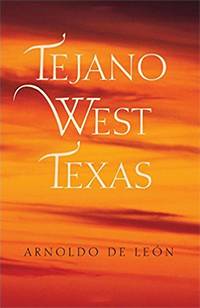
Tejano West Texas
by Arnoldo De León
College Station: Texas A&M University Press, 2015.
192 pp. $30.98 cloth.
Reviewed by
Maria Angela Diaz
“As in other parts of Texas, Anglos relied on the pobladores of West Texas to learn how to survive in the rough country. They built alliances with the Mexican American families that had constructed farms and ranches there. It was in the 1880s that these alliances broke down and the place of Mexican Texans began to shift”
Arnoldo De León’s most recent book, Tejano West Texas, seeks to fill a significant gap in the literature of Texas history and the history of Mexican Americans. As De León argues, Texas and Tejano historians have treated Mexican Americans in West Texas as peripheral to events in the centers of Tejano life such as the Rio Grande Valley and San Antonio. With this book, De León sheds light on a neglected aspect of Texas history, the role of Mexican Americans or “Tejanos” in the settlement and development of West Texas. Tejano West Texas begins in the eighteenth century and ends in the twentieth. The book is comprised of eleven chapters, each one being an article that De León wrote during his long career as a professor of history at Angelo State University.
Clearly, De León hopes to spark an interest in the history of the Tejanos of West Texas. This is a task that De León has accomplished admirably. Each chapter showcases many of the events of West Texas Tejano history that provide further understanding of the lives of Mexican Americans throughout the state. Occasionally, De León adds an interesting counter point to the experiences of Mexicans Americans in some of the more traditional “Tejano homelands” such as South Texas. Some of the more notable chapters focus on specific events such as a school walkout or a sheep shearers’ strike. Due to the fact that each chapter began as a separate article, some of the information and source materials presented are repetitive, and the book lacks a significant discussion of the place of Mexican American women in West Texas. Additionally, some of the chapters that were clearly written several decades ago tend to use outdated language and concepts. All of this aside, the book is an excellent starting point from which further studies of Mexican and Mexican Americans in West Texas will undoubtedly spring.
De León begins with defining the region that is the subject of the book. De León defines “West Texas” as the area made up of Edwards Plateau belt and the Trans-Pecos region. It spans a swath of territory from the 100th meridian west toward Hudspeth County. West Texas is not home to massive cities, rather most of the cities such as San Angelo, Del Rio, Midland, and Odessa could be classified as midsized communities. Thus, the region is and has been primarily rural. The rurality of West Texas plays a significant role in the history of Mexican Americans.
The book begins by addressing the original Spanish settlements in West Texas such as La Junta de los Rios, which was established in the 1770s. Settlers struggled with the isolation and rough conditions of the region. They fought against hunger, disease, and competition from Native Americans. Anglos did not begin moving into the region until the mid-nineteenth century. As in other parts of Texas, Anglos relied on the pobladores of West Texas to learn how to survive in the rough country. They built alliances with the Mexican American families that had constructed farms and ranches there. It was in the 1880s that these alliances broke down and the place of Mexican Texans began to shift from prominent political and economic power brokers to largely an oppressed workforce. De León cites the growth of Anglo presences as the main reason for this. Yet, this shift in power also occurred because the Tejanos of West Texas did not have the seats of Mexican American political power that could be found in other parts of the state such as San Antonio. Further, Mexican Americans in West Texas lacked the professional and political training needed to keep pace with the demographic growth of Anglos. What kept Mexican American communities together and what allowed them persevere throughout the centuries was “lo mexicano,” the cultural traditions at the heart of Tejano communities that linked them to other Tejanos in Texas and Mexicans in Mexico. These traditions were kept alive by the Tejanos that lived there and the continual influx of immigrants from Mexico reinvigorated them with each passing generation.
By the dawn of the twentieth century, Anglo hostility toward Mexican Americans and the onset of segregation constricted the economic growth of Mexican American communities throughout the region. Many Tejanos worked as ranch hands, sheep herders and shearers, and migrant agricultural workers. Despite the poverty that affected these communities, Mexican Americans consistently attempted to fight back against their oppression. In 1910, Mexican Americans in San Angelo protested efforts to segregate Mexican American children in separate schools. In 1934, sheep shearers unionized and organized a strike against sheep ranchers for higher wages and fairer contract practices. Both the walkout against the school and the sheep shearer strike did not succeed. However, as De León notes, they were examples of Mexican American perseverance. De León also describes the role of Mexican Americans from West Texas in World War II and the Korean War. He ends by discussing the lives of political and social activists, Eva Camúñez Tuker and Maria Cardenas.
Arnoldo De León’s Tejano West Texas seeks to open up new avenues of study focusing on Mexican American history in the region of West Texas, and he has done an excellent job of showing new pathways for research in this area.
Maria Angela Diaz is received her doctorate from the University of Florida in 2013. She is the Postdoctoral Teaching Fellow in Texas history at Texas Tech University.
